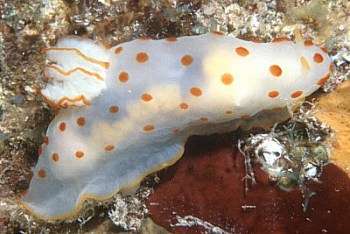
Gymnodoris ceylonica
(Kelaart, 1858)
Order: NUDIBRANCHIA
Suborder: DORIDINA
Family: Gymnodorididae
PHOTO
Enewetak Atoll, Marshall Islands. PHOTO: Scott Johnson.
First reported by Kelaart from Sri Lanka this widespread Indo-West Pacific species was next reported from the Society Islands in the western Pacific by Pease (as Trevelyana picta). It is characterised by the translucent white body with small bright orange-red spots and large orange-lined white gills.
Reference:
• Kelaart, E.F. (1858). Description of a new Ceylonese nudibranch. Annals & Magazine of Natural History, (Ser.3), 1(4): 257-258, Pl. 10B.
Rudman, W.B., 1999 (September 5) Gymnodoris ceylonica (Kelaart, 1858). [In] Sea Slug Forum. Australian Museum, Sydney. Available from http://www.seaslugforum.net/find/gymnceyl
Related messages
Gymnodoris ceylonica from Mozambique
April 9, 2008
From: Valda Fraser
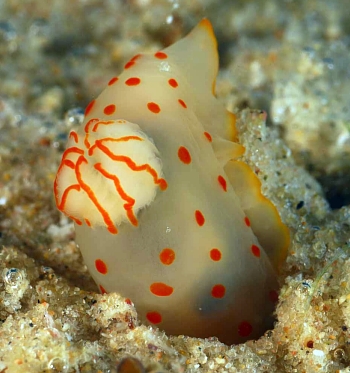
Dear Bill
Not an acceptable view at all - Gymnodoris ceylonica with it's butt in the air! What could it possibly be doing?
Locality: Pomene, 1 m, Mozambique, Indian Ocean, 18 February 2008, Pool . Length: 25 mm. Photographer: Valda Fraser.
Regards
Valda Fraser
valdafraser@mweb.co.za
Fraser, V.J., 2008 (Apr 9) Gymnodoris ceylonica from Mozambique. [Message in] Sea Slug Forum. Australian Museum, Sydney. Available from http://www.seaslugforum.net/find/21500Dear Valda,
By complete coincidence I am posting a message today from Toh Chay Joon [#21507] showing Gymnodoris rubropapulosa in a similar pose - but horizontal not vertical. I suspect your animal is in pursuit of a prey animal, or may have it in its mouth, trying to prevent its escape. When I was a student in New Zealand I used to wonder why I often found the aglajid Melanochlamys cylindrica sitting just like your animal, with its head buried deep in coralline turf, oblivious to the fact that the tide had left it uncovered on an intertidal rock platform. It was only later, when I discovered they fed on free-living polychaete worms, that I realised the reason they were head down - or butt up as you would have it - because they had a worm in their mouth which was trying to escape down a crevice, and neither prey nor predator would give up.
If you see such an event in future, you have my permission to slightly disturb the balance of nature and have a little poke around to see what they are after. We have two observations on the Forum of this species eating Stylocheilus striatus so it would be nice to know if that was their only prey.
Best wishes,
Bill Rudman
Gymnodoris ceylonica and its eggs
February 25, 2006
From: Alain Bonnet
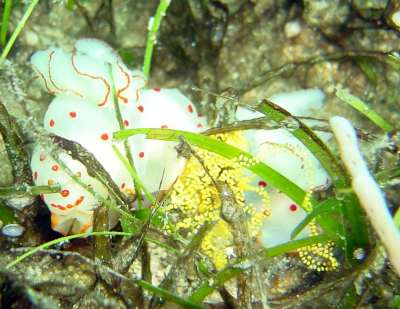
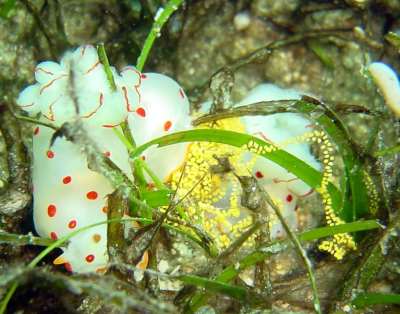
Dear Bill
Here are some photos of Gymnodoris ceylonica and its eggs from Pandan Is., Philippines.
Locality: Pandan island, 3 metres, Philippines, Mindoro Sea, march 2005, sea grass. Length: 30-40 mm
Alain Bonnet
alain.lm24@neuf.fr
Bonnet, A., 2006 (Feb 25) Gymnodoris ceylonica and its eggs. [Message in] Sea Slug Forum. Australian Museum, Sydney. Available from http://www.seaslugforum.net/find/15910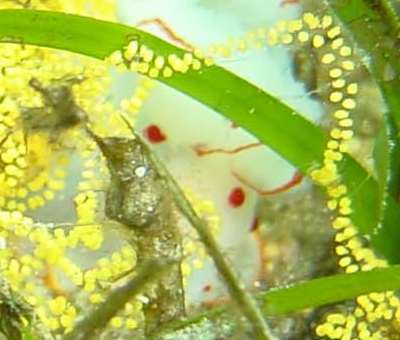
Dear Alain,
Thanks for these nice photos. G. ceylonica seems to inhabit these open grass beds. I must say its egg mass is almost as messy as that of a sea hare, quite different from the precise spiral bands of most other dorid nudibranchs.
Best wishes,
Bill Rudman
Gymnodoris ceylonica eating Stylocheilus
February 25, 2006
From: Alain Bonnet
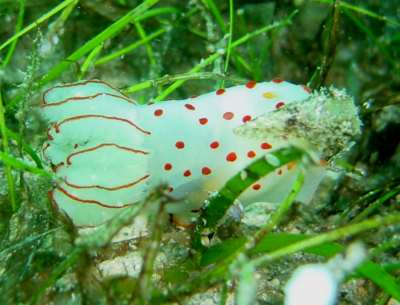
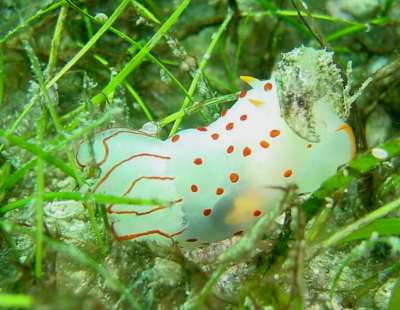
Dear Bill
Here are some photos Stylocheilus striatus being eaten by Gymnodoris ceylonica in Pandan isl, Philippines.
Locality: Pandan island, 3 metres, Philippines, Mindoro sea, march 2005, on sea grass. Length: 30-40 mm. Photographer: Alain Bonnet.
Alain Bonnet
alain.lm24@neuf.fr
Bonnet, A., 2006 (Feb 25) Gymnodoris ceylonica eating Stylocheilus. [Message in] Sea Slug Forum. Australian Museum, Sydney. Available from http://www.seaslugforum.net/find/15912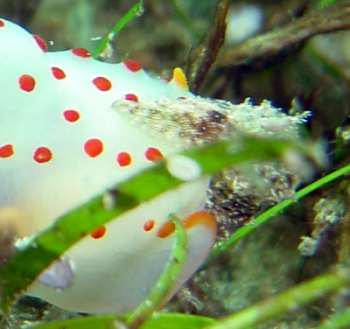
Dear Alain,
Thanks for these. Form messages to the Forum, it looks as though Stylocheilus is one of the common prey items of Gymnodoris ceylonica
Best wishes,
Bill Rudman
Re: Aggregation of Stylocheilus striatus [2]
January 23, 2006
From: Paul Whitehead
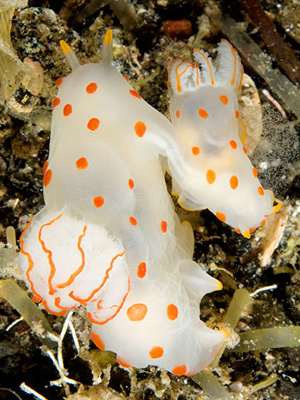
Concerning message #15378 on aggregation of Stylocheilus:
Dear Bill,
As promised attached are some photos of the other two aggregation species, which all aggregated with the same week and on the same site (Retal Larry, Lembeh Straits) following the spetember full moon.
Locality: Retak larry. Lembeh Straits, Indonesia. Depth: 3 meters. 15 September 2005. black sand beach with sparse cover. Photographer: Paul Whitehead
Immediately after the Stylocheilus aggregation this "white" species aggregated over the site are covering an area of about 20 meters by 20 meters and avaeraging about 10 animals per square meter. Whilst this aggregation was occurring the third species [see message #15629] aggregated covering the same area with about 10 animals per square meter again.
The whole cycle of the three aggregations lasted 1 week.
Paul
pw@whiteheadimages.com
Whitehead, Paul, 2006 (Jan 23) Re: Aggregation of Stylocheilus striatus [2]. [Message in] Sea Slug Forum. Australian Museum, Sydney. Available from http://www.seaslugforum.net/find/15630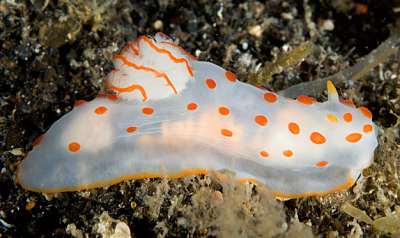
Dear Paul,
Thanks for following up with these photos. It is certainly an interesting st of observations. I guess the sequence is a response to the same physical conditions - water temperature, currents etc - as these animal are not really equipped to quickly gang up on their prey when a prey species is in large numbers. This 'white' one is Gymnodoris ceylonica. It certainly is known to occur in large aggregations. See Scott Johnson's message [#1289] where he suggests they move from deeper water to spawn. Interestingly, species of Gymnodoris, eat other opisthobranchs, but I don't recall if Stylocheilus has been recorded as part of their diet.
Best wishes,
Bill Rudman
Gymnodoris ceylonica from Reunion Island
February 14, 2005
From: Philibert Bidgrain
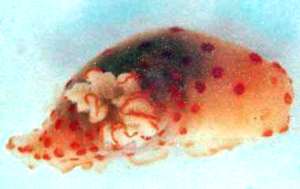
Dear Bill,
Reunion Island sea slugs.
We have only this one specimen of Gymnodoris ceylonica, observed by Maurice Jay. A few years ago...The photo is of a poor quality, but right now, I haven't another specimen, from Reunion Island...
Best regards
Philibert Bidgrain
http://vieoceane.free.fr/runseaslug/indexslug.htm
pbidgrain@yahoo.fr
Bidgrain, P., 2005 (Feb 14) Gymnodoris ceylonica from Reunion Island. [Message in] Sea Slug Forum. Australian Museum, Sydney. Available from http://www.seaslugforum.net/find/13105Dear Philibert,
Yes this is Gymnodoris ceylonica.
Best wishes,
Bill Rudman
Gymnodoris ceylonica from the Red Sea
July 3, 2003
From: Michael Mrutzek
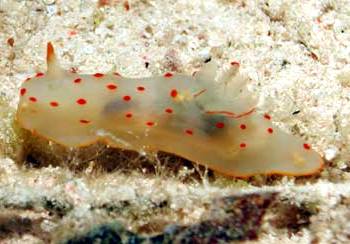
Dear Bill
I think this is Gymnnodoris ceylonica. I photographed it in the Red Sea in May, 2003
Michael Mrutzek
Michael@meeresaquaristik.de
Mrutzek, M., 2003 (Jul 3) Gymnodoris ceylonica from the Red Sea. [Message in] Sea Slug Forum. Australian Museum, Sydney. Available from http://www.seaslugforum.net/find/10044Thanks Michael,
Your identification is correct
Bill Rudman
Gymnodoris ceylonica from French Polynesia
November 11, 2002
From: Christophe Naslain
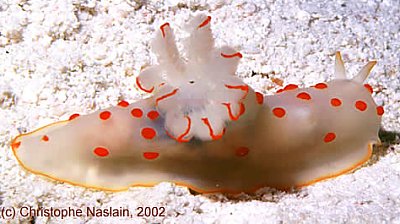
Hi Bill,
Here are a few pictures of Gymnodoris ceylonica taken in Bora Bora, French Polynesia (from my last trip in July-August 2002). All pictures taken in free diving at about 4-5 metres deep with a Nikon F90X-Subal Housing and SB105 strobe. It was close to sunset time, 5pm. I've seen on the same area 4 or 5 G. ceylonica.
I love this species
best wishes,
Christophe
http://wttfw.freesurf.fr
chris.n@free.fr
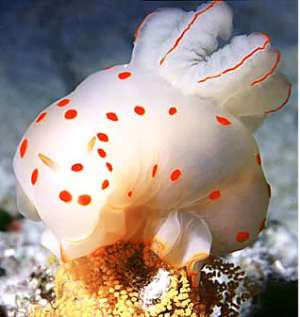
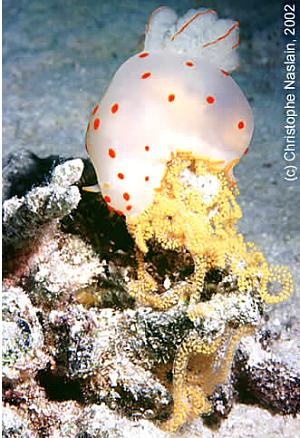
Thanks Christophe,
I agree that this is a spectacular species.
Best wishes,
Bill Rudman
Juvenile Gymnodoris ceylonica from Bali
March 20, 2002
From: Stuart Hutchison
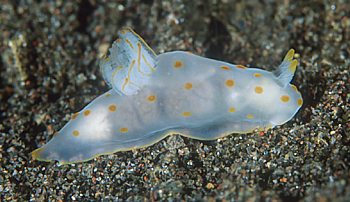
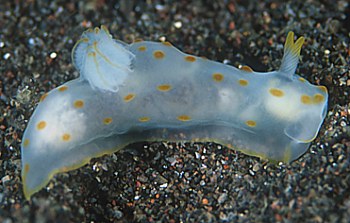
Bill,
Here's a Gymnodoris from Bali, Indonesia on 24 Oct 2001. Depth 5m, lengths around 10mm.
Stuart
stuart@stuarthutchison.com.au
Hutchison, S., 2002 (Mar 20) Juvenile Gymnodoris ceylonica from Bali. [Message in] Sea Slug Forum. Australian Museum, Sydney. Available from http://www.seaslugforum.net/find/6280Thanks Stuart,
This is a juvenile of Gymnodoris ceylonica.
Best wishes,
Bill Rudman
Gymnodoris ceylonica from French Polynesia
October 15, 2001
From: Daniel Geiger
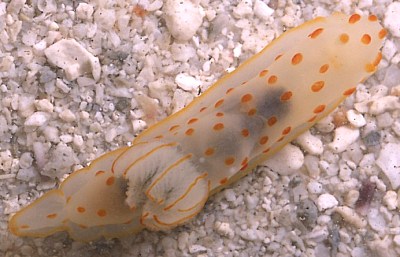
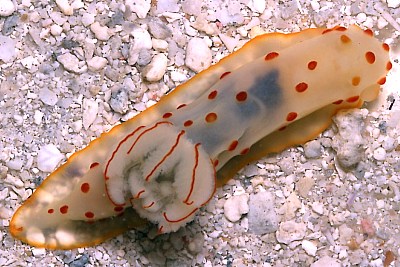
Hi Bill
Here are some photos of Gymnodoris ceylonica from French Polynesia, Moorea, August 2001. Animals both approx. 5 cm. long
Daniel.
dgeiger@nhm.org
Geiger, D., 2001 (Oct 15) Gymnodoris ceylonica from French Polynesia. [Message in] Sea Slug Forum. Australian Museum, Sydney. Available from http://www.seaslugforum.net/find/5434Thanks Daniel,
Bill Rudman
Gymnodoris ceylonica from Papua New Guinea
June 14, 2001
From: Stuart Hutchison
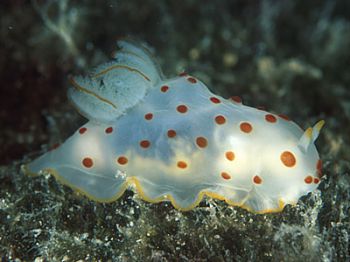
Bill,
Here's a nice Gymnodoris ceylonica from Milne Bay, PNG. March 1999, 7m, 50mm long and one of seven that we caught procreating all at once. Unfortunately, they went their seven separate ways immediately after and I didn't get a chance to take a shot beforehand.
Regards,
Stuart
hutchco@tpg.com.au
Hutchison, S., 2001 (Jun 14) Gymnodoris ceylonica from Papua New Guinea. [Message in] Sea Slug Forum. Australian Museum, Sydney. Available from http://www.seaslugforum.net/find/4490Thanks Stuart,
Bill Rudman
Gymnodoris ceylonica from Tonga
May 27, 2001
From: Don Barclay
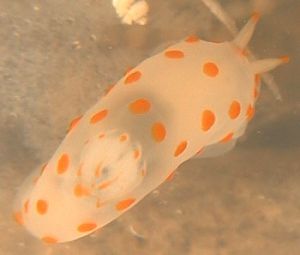
Hello Bill,
I finally got around to sorting out the photos I took in February, 2001, in Vava'u, Tonga. Most of the slugs were easy to identify, as many were the same species (and same forms) found on Heron Island. There was surprisingly little overlap with the ones that I see in Samoa.
I still have a couple that have eluded me, and here is one of them. It is a little white nudibranch with raised orange spots, and orange tips on the rhinophores. It looks quite distinctive, so I would think it wouldn't be too hard to identify.
This 12mm nudibranch was found crawling on sand in 14 meters of water across the channel from the Tongan Beach Resort, Utungake Island, Vava'u, Tonga. It was found about noon on 16 February 2001.
I kept trying to turn him over or get a photo of his head, but he could flip back over quicker than I could get the camera to focus, and he would "duck" his head immediately once he had righted himself. I finally gave up, and all I got was this rear view. Can you identify it for me?
Thanks,
Don
n5ols@samoatelco.com
Barclay, D., 2001 (May 27) Gymnodoris ceylonica from Tonga. [Message in] Sea Slug Forum. Australian Museum, Sydney. Available from http://www.seaslugforum.net/find/4258Dear Don,
This is a juvenile Gymnodoris ceylonica. When I first found juveniles I thought they were a distinct species but their anatomy is identical.
Best wishes,
Bill Rudman
Gymnodoris ceylonica from Solomon Ids
December 22, 2000
From: Bruce Potter
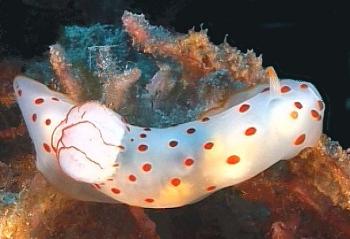
Dear Bill,
I am sending you a picture of Gymnodoris ceylonica that I filmed recently at a site just near Honiara, Solomon Islands.
It was at about 16 meters on a rubble, and sea grass area. It was very active, moving around quite quickly. It would have been about 40mm long.
Regards
Bruce Potter.
bruce.potter@adventist.org.sb
Potter, B., 2000 (Dec 22) Gymnodoris ceylonica from Solomon Ids. [Message in] Sea Slug Forum. Australian Museum, Sydney. Available from http://www.seaslugforum.net/find/3395Thanks Bruce,
It must be the time of year for this animal in the south Pacific as Angel Valdes, who was with me in Lifou, found a large population of these spectacular animals.
Bill Rudman.
Re: Fused Rhinopores
September 16, 1999
From: Wayne Ellis
Hi Bill,
Concerning Scott's photo of fused rhinophores in
Wayne
glaskin@ozemail.com.au
Ellis, W., 1999 (Sep 16) Re: Fused Rhinopores. [Message in] Sea Slug Forum. Australian Museum, Sydney. Available from http://www.seaslugforum.net/find/1342Re: Feeding & Breeding in Gymnodoris ceylonica
September 15, 1999
From: Scott Johnson
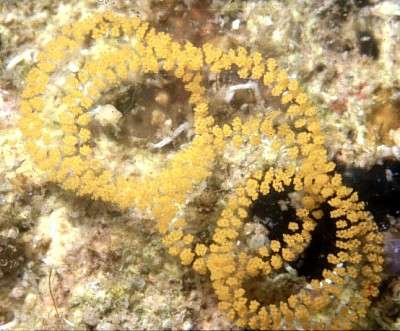
Hi Bill,
Regarding your response to my photos of G. ceylonica: thanks for the compliment and only too happy to oblige with the egg mass photos. However, I have to say that after boasting about seeing all these G. ceylonica egg masses, I found to my embarrassment that I seem to have only a single photo of it--and not a very good one at that. Could be my own fault. Mail delivery to Enewetak was slow, and turnaround for professional slide processing could easily be 6 weeks, so I did much of it myself. It is certainly conceivable that I completely destroyed any pics I took the times I saw numerous egg masses. Anyway, the one I have does show the loosely spiralled masses they produce. And to make up for the lack, I also included 3 photos of the egg production process.
Scott
johnson@kmr.ll.mit.edu
Johnson, S., 1999 (Sep 15) Re: Feeding & Breeding in Gymnodoris ceylonica. [Message in] Sea Slug Forum. Australian Museum, Sydney. Available from http://www.seaslugforum.net/find/1335No need to apologise for the photo Scott, it complements Julie Marshall's close-up photo. I remember in Tanzania having to send my film to England for processing, where they often seem to be on strike - sometimes for 3 or more months. It was like a surprise present when slides I'd given up on, finally arrived.
Do you know of any other gymnodorid, any nudibranch for that matter, which lays its eggs in little clusters like this? It reminds me of an epitoniid egg mass which also has the eggs in clusters.
Best wishes,
Bill Rudman.
Mating in Gymnodoris ceylonica
September 15, 1999
From: Scott Johnson
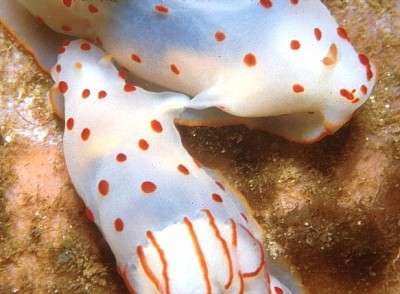
Hi Bill,
To make up for my lack of photos of the Gymnodoris ceylonica egg mass, here are 3 photos of the 'egg production process'. The pictures are, I think, self-explanatory.
Scott
johnson@kmr.ll.mit.edu
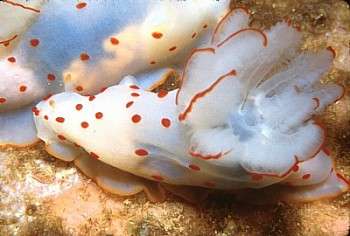
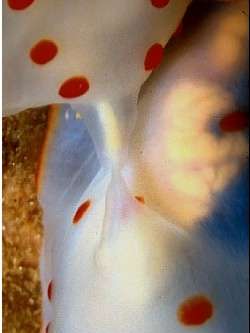
Dear Scott,
Thanks for the great photos. I sometimes wonder whether all nudibranch matings are in fact reciprocal. In this instance (LOWER RIGHT) it seems that the lower animal is acting as a male and the upper as a female.
Another interesting feature are the fused rhinophores (UPPER RIGHT) in one of the slugs. I can't say this is common anywhere in the Nudibranchia, but this is the third species of Gymnodoris in which I have seen fused rhinophores.
Bill Rudman.
Eggs of Gymnodoris ceylonica
September 14, 1999
From: Julie Marshall
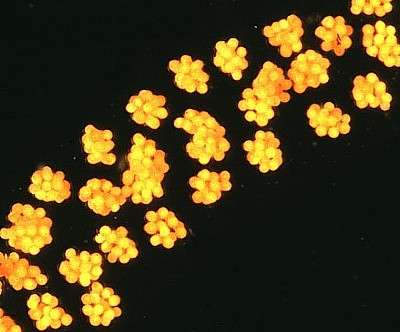
Dear Bill,
Last week Scott Johnson posted some spectacular photos of Gymnodoris ceylonica. Attached is a photo of the eggs of this species. The egg mass was laid by an animal brought into the laboratory.
It was one of 18 animals found within a few days on the reef flat at Heron Island in November 1997.
Best wishes,
Julie Marshall
j.marshall@latrobe.edu.au
Marshall, J., 1999 (Sep 14) Eggs of Gymnodoris ceylonica. [Message in] Sea Slug Forum. Australian Museum, Sydney. Available from http://www.seaslugforum.net/find/1330Thanks Julie,
It is interesting to see the eggs arranged in clusters of 20-40 as described by Johnson & Boucher (1983). According to them each egg has its individual capsule, as normal in opisthobranchs.
Bill Rudman.
Feeding & breeding in Gymnodoris ceylonica
September 9, 1999
From: Scott Johnson

Hi Bill,
Gymnodoris ceylonica is a species that seems to occasionally engage in mass movements into shallow water to spawn. My first encounter with the species was at Enewetak Atoll in September of 1981, when I came across six specimens crawling up a sandy lagoon slope at depths of between 6 and 15 meters. Three days later, I returned to the same area. This time I counted 80 individuals in a 10 minute swim that dropped as deep as 25 meters on the slope. All were crawling upward toward shallow water. Up shallow, at a depth of about 2-4 meters, these animals were depositing egg masses on just about everything. It looked like there were hundreds of egg masses. When not spawning, they were busy eating Stylocheilus (bottom pics). I saw this happen several times at Enewetak in the early 80s, but have not observed it at Kwajalein over the past 11 years.
Scott
johnson@kmr.ll.mit.edu
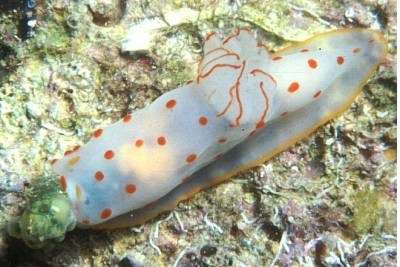
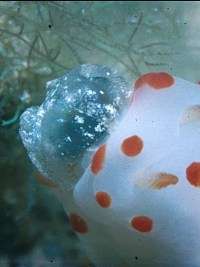
Thanks Scott,
After these great photos it seems a bit churlish to ask if you have any egg-mass photos to share.
Bill Rudman.
